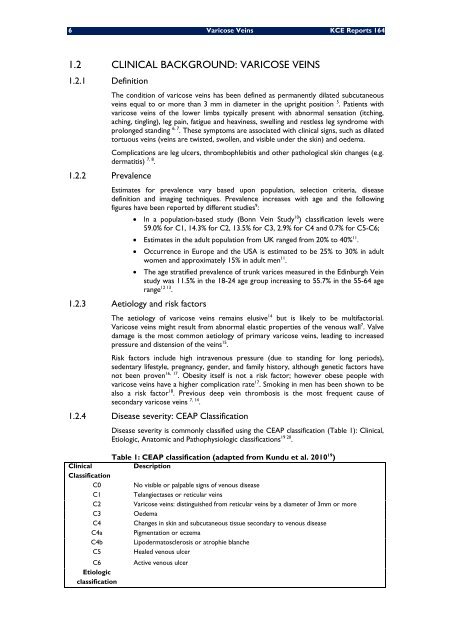Diagnostic et traitement des varices des membres inférieurs - KCE
Diagnostic et traitement des varices des membres inférieurs - KCE
Diagnostic et traitement des varices des membres inférieurs - KCE
You also want an ePaper? Increase the reach of your titles
YUMPU automatically turns print PDFs into web optimized ePapers that Google loves.
6 Varicose Veins <strong>KCE</strong> Reports 164<br />
1.2 CLINICAL BACKGROUND: VARICOSE VEINS<br />
1.2.1 Definition<br />
The condition of varicose veins has been defined as permanently dilated subcutaneous<br />
veins equal to or more than 3 mm in diam<strong>et</strong>er in the upright position 5 . Patients with<br />
varicose veins of the lower limbs typically present with abnormal sensation (itching,<br />
aching, tingling), leg pain, fatigue and heaviness, swelling and restless leg syndrome with<br />
prolonged standing 6, 7 . These symptoms are associated with clinical signs, such as dilated<br />
tortuous veins (veins are twisted, swollen, and visible under the skin) and oedema.<br />
Complications are leg ulcers, thrombophlebitis and other pathological skin changes (e.g.<br />
dermatitis) 7, 8 .<br />
1.2.2 Prevalence<br />
Estimates for prevalence vary based upon population, selection criteria, disease<br />
definition and imaging techniques. Prevalence increases with age and the following<br />
figures have been reported by different studies 9 :<br />
• In a population-based study (Bonn Vein Study 10 ) classification levels were<br />
59.0% for C1, 14.3% for C2, 13.5% for C3, 2.9% for C4 and 0.7% for C5-C6;<br />
• Estimates in the adult population from UK ranged from 20% to 40% 11 .<br />
• Occurrence in Europe and the USA is estimated to be 25% to 30% in adult<br />
women and approximately 15% in adult men 11 .<br />
• The age stratified prevalence of trunk <strong>varices</strong> measured in the Edinburgh Vein<br />
study was 11.5% in the 18-24 age group increasing to 55.7% in the 55-64 age<br />
range 12 13 .<br />
1.2.3 A<strong>et</strong>iology and risk factors<br />
The a<strong>et</strong>iology of varicose veins remains elusive 14 but is likely to be multifactorial.<br />
Varicose veins might result from abnormal elastic properties of the venous wall 7 . Valve<br />
damage is the most common a<strong>et</strong>iology of primary varicose veins, leading to increased<br />
pressure and distension of the veins 15 .<br />
Risk factors include high intravenous pressure (due to standing for long periods),<br />
sedentary lifestyle, pregnancy, gender, and family history, although gen<strong>et</strong>ic factors have<br />
not been proven 16, 17 . Obesity itself is not a risk factor; however obese people with<br />
varicose veins have a higher complication rate 17 . Smoking in men has been shown to be<br />
also a risk factor 18 . Previous deep vein thrombosis is the most frequent cause of<br />
secondary varicose veins 7, 14 .<br />
1.2.4 Disease severity: CEAP Classification<br />
Disease severity is commonly classified using the CEAP classification (Table 1): Clinical,<br />
Etiologic, Anatomic and Pathophysiologic classifications 19 20 .<br />
Table 1: CEAP classification (adapted from Kundu <strong>et</strong> al. 2010 19 Clinical<br />
)<br />
Description<br />
Classification<br />
C0 No visible or palpable signs of venous disease<br />
C1 Telangiectases or r<strong>et</strong>icular veins<br />
C2 Varicose veins: distinguished from r<strong>et</strong>icular veins by a diam<strong>et</strong>er of 3mm or more<br />
C3 Oedema<br />
C4 Changes in skin and subcutaneous tissue secondary to venous disease<br />
C4a Pigmentation or eczema<br />
C4b Lipodermatosclerosis or atrophie blanche<br />
C5 Healed venous ulcer<br />
C6<br />
Etiologic<br />
classification<br />
Active venous ulcer

















